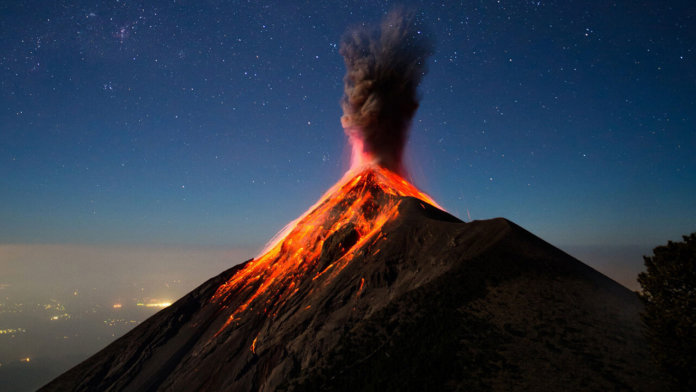Volcanic activity is one of the forces of nature that can change the face of the Earth. And at the moment, the underground forces continue their titanic work. Made from many layers of lava, monstrous in size, the largest volcanoes in the world lurk under the water surface or hang over the nearby cities.
Which of them are considered the largest? Scientists have not yet come to a consensus. Some believe that it is necessary to build a rating according to the height above sea level. Others - what to consider is the area over which the lava flows are spreading, forming a new surface. Still others - that the human factor is primarily important: the danger to human settlements.
Therefore, for the rating of the largest volcanoes on planet Earth, we have chosen representatives of all types - the largest in area, and the highest, and the most dangerous active and extinct volcanoes.
10. Etna - height 3,295 meters
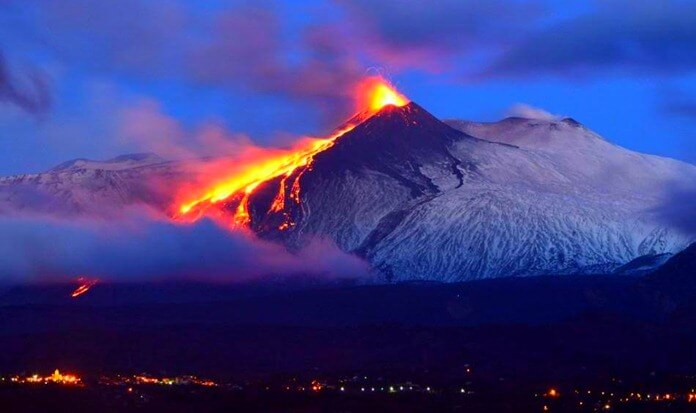 The highest volcano in Europe is located on the island of Sicily and is still active. The last eruption began on December 25, 2018. Due to frequent eruptions, it is impossible to accurately determine its height - it is constantly changing. For example, over the past 30 years, Etna has "lost" more than 20 meters in height. At the moment, it rises above the island at 3,295 m.
The highest volcano in Europe is located on the island of Sicily and is still active. The last eruption began on December 25, 2018. Due to frequent eruptions, it is impossible to accurately determine its height - it is constantly changing. For example, over the past 30 years, Etna has "lost" more than 20 meters in height. At the moment, it rises above the island at 3,295 m.
The mountain is famous for its bad character - its slopes are dotted with craters, from where once every couple of months lava is steadily pouring out. About once a century, eruptions are larger, posing a direct threat to human settlements inhabiting the slopes. However, this does not stop stubborn people - due to frequent eruptions, the soil on the slopes of the mountain is rich in elements useful for plants that allow you to harvest large harvests.
9. Erebus - 3 794 meters
 If the rest of the volcanoes are in the inhabited part of the world, then Erebus is located on the uninhabited continent of Antarctica. It is the largest active volcano in the south polar region. Despite the lifeless ice spaces surrounding it, Erebus leads a very active life. And its geographical position - exactly over several faults in the earth's crust - contributes a lot to this.
If the rest of the volcanoes are in the inhabited part of the world, then Erebus is located on the uninhabited continent of Antarctica. It is the largest active volcano in the south polar region. Despite the lifeless ice spaces surrounding it, Erebus leads a very active life. And its geographical position - exactly over several faults in the earth's crust - contributes a lot to this.
Despite the fact that people do not live near Erebus, it still affects their lives in a negative sense. From the depths of the volcano, streams of gases contained inside the Earth periodically break out, mainly methane and hydrogen, which destroy the ozone layer. It is believed that the smallest thickness of the ozone sea is exactly in the area of the volcano.
8. Klyuchevskaya Sopka - 4,835 meters
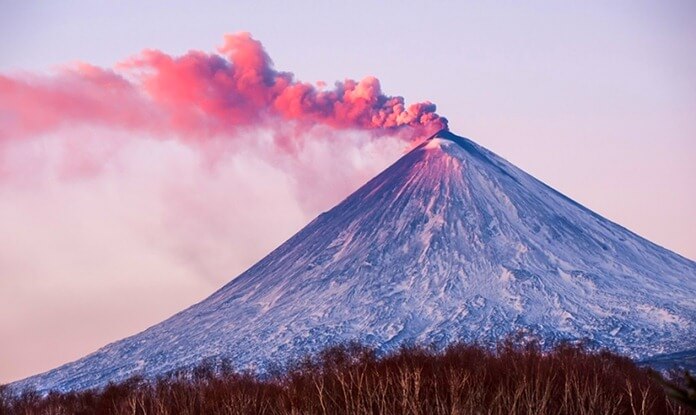 Like Etna, the height of the Klyuchevskoy volcano is constantly changing. Although it lost about 15 meters after an eruption five years ago, it still remains the tallest active volcano in Russia and Asia.
Like Etna, the height of the Klyuchevskoy volcano is constantly changing. Although it lost about 15 meters after an eruption five years ago, it still remains the tallest active volcano in Russia and Asia.
Although, in comparison with other peaks of Kamchatka, the Klyuchevsky volcano loses in frequency, it successfully compensates for this with power.For example, the eruption of 1938 lasted 13 months and caused the emergence of several craters up to 1,900 m high. And the eruption of 1980 tore off and threw a block of ice with an area of at least half a kilometer into the air to a height of more than 500 m.
But the most spectacular and most terrible eruption was in 1994, when an impressive column of ash more than 12 km high rose above the volcano, and a plume of volcanic ash extended from the ejection site for many tens of kilometers and disappeared somewhere in the ocean.
7. Orizaba - 5,636 meters
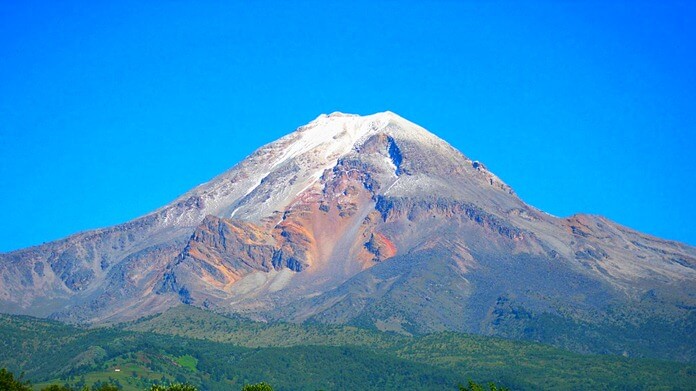 “It must be that the top of the volcano touches the sky itself,” the ancient Incas probably thought and gave it the name Sitlaltepetl, or “Star Mountain”. It is the tallest active volcano in North and Central America and the third largest peak in the region. It can be seen from afar - many miles before the coast, the cone of Orizaba can be seen from the side of the ship following through the Gulf of Mexico to the port of Veracruz.
“It must be that the top of the volcano touches the sky itself,” the ancient Incas probably thought and gave it the name Sitlaltepetl, or “Star Mountain”. It is the tallest active volcano in North and Central America and the third largest peak in the region. It can be seen from afar - many miles before the coast, the cone of Orizaba can be seen from the side of the ship following through the Gulf of Mexico to the port of Veracruz.
Although now the volcano is asleep, its calmness is deceiving - it led a very active existence from the moment the conquistadors came to these places until the 19th century, and in recent years the station located at its foot has recorded constant internal activity.
6. Elbrus - 5 642 meters
 The highest mountain is also the largest volcano in Russia and Europe. Glaciers descending from the snow-covered surface give rise to several significant rivers that feed the plains of the Caucasus region.
The highest mountain is also the largest volcano in Russia and Europe. Glaciers descending from the snow-covered surface give rise to several significant rivers that feed the plains of the Caucasus region.
In addition to beauty, the snow-white cone with two peaks and a small saddle between them is distinguished by a meek and peaceful character. Elbrus has been sleeping for a long time, and its last eruption was more than 5,000 years ago. Despite the external severity, it is easy and simple to climb Elbrus - climbing routes to the top of the sleeping patriarch are one of the most uncomplicated.
5. Kilimanjaro - 5,885 meters
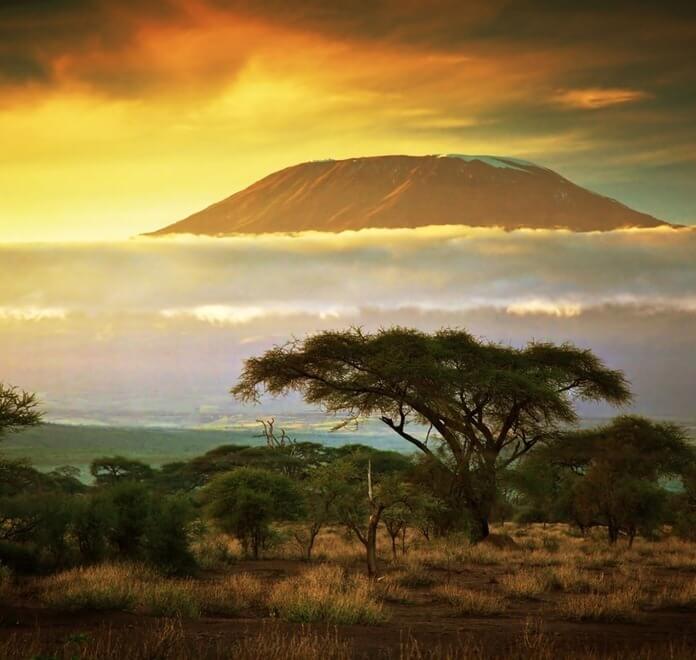 The magnificent handsome Kilimanjaro is the visiting card of Africa, its largest volcano. The sleeping giant is actually three volcanic cones that are visible from almost anywhere in neighboring Tanzania and Kenya.
The magnificent handsome Kilimanjaro is the visiting card of Africa, its largest volcano. The sleeping giant is actually three volcanic cones that are visible from almost anywhere in neighboring Tanzania and Kenya.
Unlike many of the rated volcanoes, Kilimanjaro is the most famous volcano in the world, a typical stratovolcano. If you ask a child to depict him, most likely, he will draw a conical mountain, from the top of which ash, burning gases and very viscous lava are erupting, which quickly solidifies, building a cone higher and higher. This is a stratovolcano. The size of Kilimanjaro is 4,800 km3, and its height is 5,885 m. The volcano was last active at the dawn of mankind - 360,000 years ago.
4. Ojos del Salado - 6,893 meters
 If the second and third places in the ranking are the largest volcanoes in the world, if you count from the seabed, then Ojos del Salado is the highest volcano in the world, located above the sea surface. It rises 6 893 m above the ground. The giant mountain is located on the border between Argentina and Chile.
If the second and third places in the ranking are the largest volcanoes in the world, if you count from the seabed, then Ojos del Salado is the highest volcano in the world, located above the sea surface. It rises 6 893 m above the ground. The giant mountain is located on the border between Argentina and Chile.
Although the last active volcanic eruption took place even before the invention of writing by mankind - no data about it survived - however, Ojos del Salado cannot be called sleeping in the full sense of the word. In the depths of a huge mountain, as if a mysterious hidden work, the echo of which reaches the inhabitants of the land in the form of clouds of steam and ash. The last such activity took place quite recently - in 1993.
3. Mauna Loa - 9 800 meters
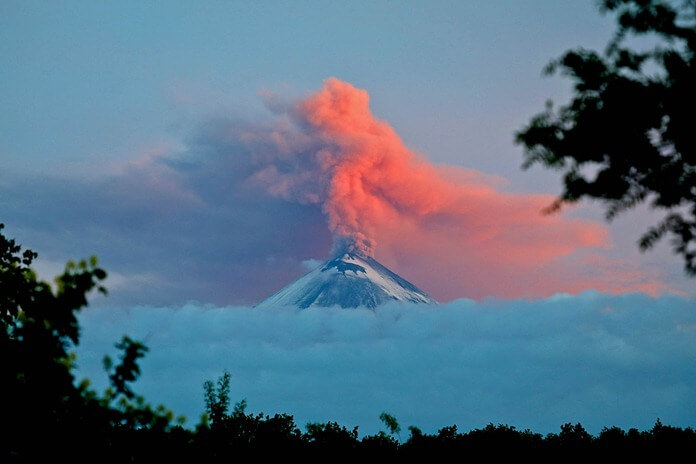 Mauna Loa is an underwater volcano whose summit (along with five others) gave rise to the Big Island of the Hawaii Archipelago. The size of Mauna Loa is 40,000 km3, the area is 75,000 m2, and the height (if you count from the seabed) is as much as 9,800 m.And it is the highest active volcano in the world - the last eruption of Mauna Loa was only 34 years ago, in 1984 year. Over the past 170 years, Mauna Loa has scared people with its activity, throwing out lava, 33 times.
Mauna Loa is an underwater volcano whose summit (along with five others) gave rise to the Big Island of the Hawaii Archipelago. The size of Mauna Loa is 40,000 km3, the area is 75,000 m2, and the height (if you count from the seabed) is as much as 9,800 m.And it is the highest active volcano in the world - the last eruption of Mauna Loa was only 34 years ago, in 1984 year. Over the past 170 years, Mauna Loa has scared people with its activity, throwing out lava, 33 times.
2. Mauna Kea - 10,058 meters
 "Sister" Mauna Loa rises almost 4,267 meters above sea level. It seems to be a little, right? However, Mauna Kea has more potential hidden than meets the eye - its base is located deep under the water column at a depth of more than 6,000 m. This makes Mauna Kea the highest mountain in the world... If it were located entirely on land, it would break the record of all the highest volcanoes in the world, beating the "land" favorite Ojos del Salado by almost 3,000 m.
"Sister" Mauna Loa rises almost 4,267 meters above sea level. It seems to be a little, right? However, Mauna Kea has more potential hidden than meets the eye - its base is located deep under the water column at a depth of more than 6,000 m. This makes Mauna Kea the highest mountain in the world... If it were located entirely on land, it would break the record of all the highest volcanoes in the world, beating the "land" favorite Ojos del Salado by almost 3,000 m.
At the top of Mauna Kea, humidity is very low and there are almost never clouds - now there is one of the largest observatories in the world.
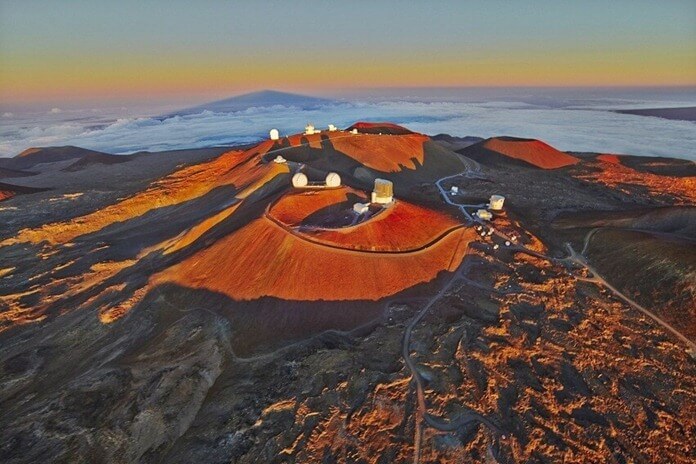 Mauna Kea arose over a hot spot of the earth - a place where hot and molten magma rises from the mantle layer of the Earth. For millions of years, molten rock emanating outward has created the surface of the entire Hawaiian archipelago. Mauna Kea is a dormant volcano; this means that it has been inactive for more than 4,000 years, and the hot spot of magma outcropping has shifted. However, inaction does not mean that he will doze forever.
Mauna Kea arose over a hot spot of the earth - a place where hot and molten magma rises from the mantle layer of the Earth. For millions of years, molten rock emanating outward has created the surface of the entire Hawaiian archipelago. Mauna Kea is a dormant volcano; this means that it has been inactive for more than 4,000 years, and the hot spot of magma outcropping has shifted. However, inaction does not mean that he will doze forever.
1. The largest volcano in the world: Tamu Massif - 4000 meters
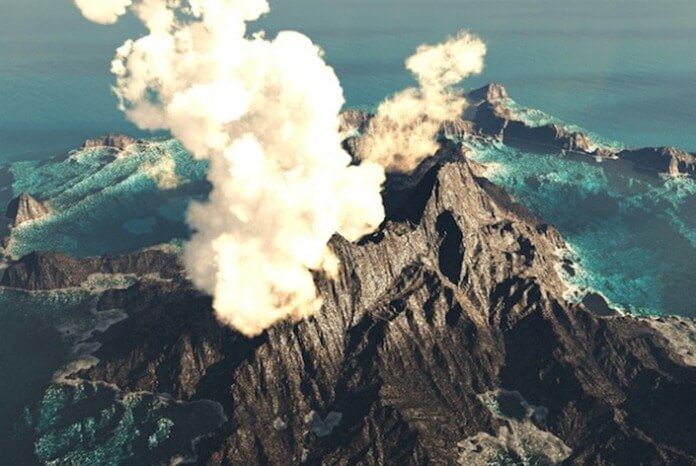 "How, only 4000 meters - and the largest volcano in the world?" - the reader may be indignant. Yes, Tamu's height is not very impressive. But let's look at it in more detail from all sides.
"How, only 4000 meters - and the largest volcano in the world?" - the reader may be indignant. Yes, Tamu's height is not very impressive. But let's look at it in more detail from all sides.
Most of the largest natural objects in the world, mankind discovered long ago, at the dawn of its existence. But the Tamu massif - the largest volcano on planet Earth - has managed to hide from people for many years.
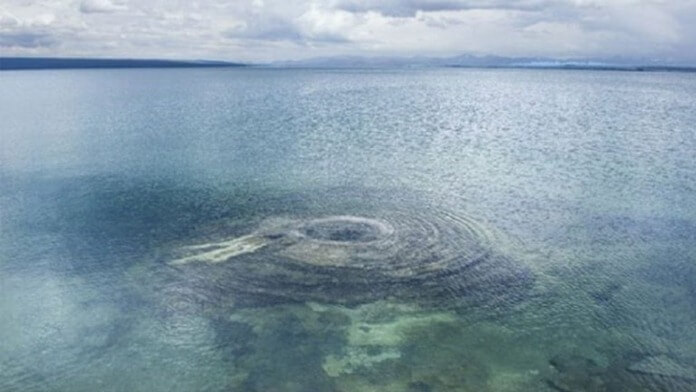
It is amazing that humanity knew more about the huge volcanoes on Mars than about the giant mountain under its very nose. The reason is both its remote location (it is more than 1,600 km east of Japan) and its depth. Its summit is immersed in the thickness of the World Ocean for 2,000 km. It was only in 2013 that scientists discovered that the striking lava mountain at the bottom of the ocean is in fact one and only volcano.
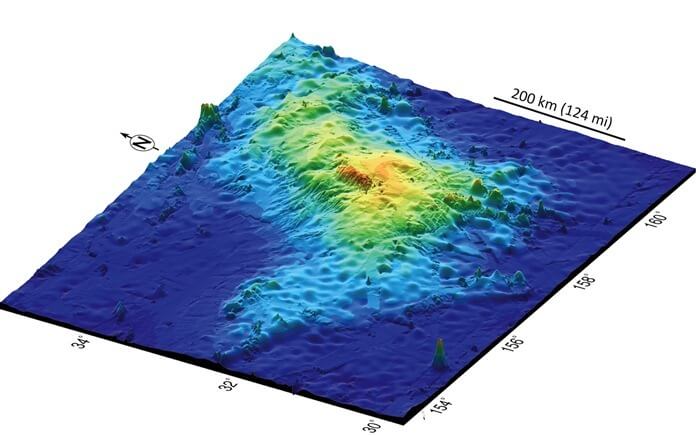
Its volume is approximately 2.5 million km3, and its area is more than 311 km2. Fortunately, he has been sleeping for a long time - the last eruption of Tamu was about 144 million years ago.
The most dangerous volcano in the world
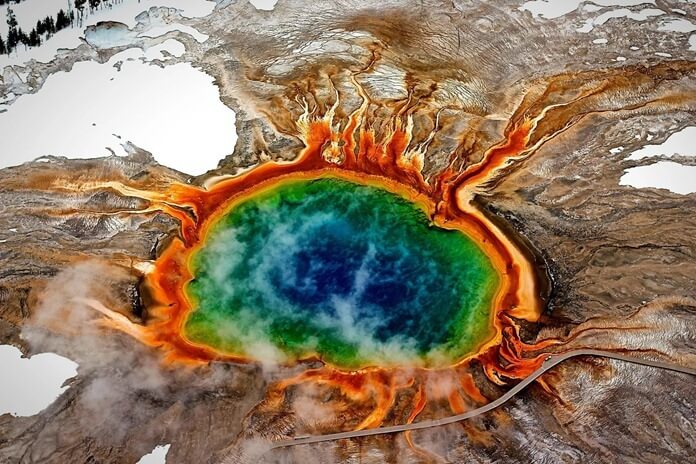 Supervolcano Yellowstone is considered the most active and dangerous today. Located in the US National Park, it poses a huge threat not only to Wyoming, but to the entire planet. It is believed that the eruption of the Yellowstone Volcano could lead to climate change throughout the Earth.
Supervolcano Yellowstone is considered the most active and dangerous today. Located in the US National Park, it poses a huge threat not only to Wyoming, but to the entire planet. It is believed that the eruption of the Yellowstone Volcano could lead to climate change throughout the Earth.

As a result of the disaster, more than 70% of the US territory will be destroyed. Magma and pellets will cover the area with a 3-meter layer. The losses will amount to more than 10 million lives, and the territory will become uninhabited due to the high level of radiation.
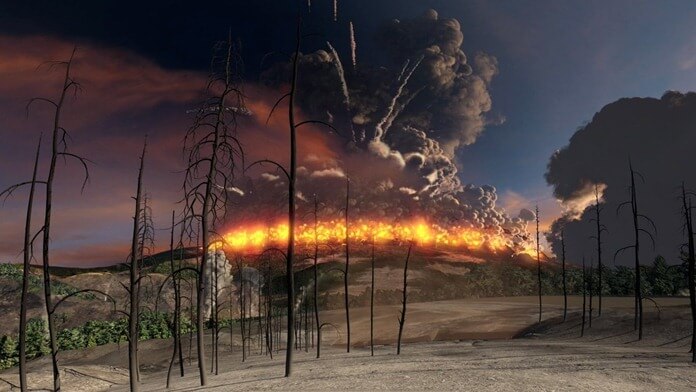
Today, visits to the park are limited; in some areas, entry is completely prohibited. Scientists are carefully examining the caldera, and the eruption could begin in the coming decades.

